 This work is licensed under a
Creative Commons Attribution-NonCommercial-ShareAlike 2.5 License.
This work is licensed under a
Creative Commons Attribution-NonCommercial-ShareAlike 2.5 License.
honeybees: an admirable life-form
Steadying at 50 hives in 7 locations, James was a larger scale “hobbyist” beekeeper or small scale “sideliner” depending on your point of view. Income coverered the large costs, particularly travel to the apiaries given the weekly visits to hives for maintenance. The enterprise had a trading name of Honey Mountain, based on Godolphin Hill, where we lived. It started as a hobby to complement organic gardening and growing. It became so compelling and absorbing, that 3 hives in 1992 became 5 in 1994, expanding to 13 in 1996, 30 in 1997 and then steadying at around 50 from 1998 reducing back to 30 once I left Trevarno estate to a colleague. Having retired from a full-time intensive occupation in training and consultancy work, beekeeping provided a total contrast: “Bees’ stings hurt less than human stings and the hurt doesn’t last as long!”
The beauty in a colony of honey bees at work is astounding and the task of managing bees provides a regular opportunity to appreciate the subtlety, simplicity and complexity of life along with its unfathomable nature. It appears as a profound reflection of our most basic and fundamental nature – that we are alive in a world full of life, interconnected with it all, yet at first sight separate at a personal and planetary level. This regular contact is nourishing and brings the privilege of supporting these independent colonies in a way that brings a harvest for many people to enjoy and gives the local environment pollinators and admirable insect life. The work also sustains these industrious insects, which might otherwise die out, due to the spread of a parasitic mite (varroa destructor), whose effects lead to the demise of an unmanaged colony including feral colonies. (Actually competent beekeepers can always replace their bees as one major issue with bees is they are prolific breeders. We can create 10 times as many colonies as we have every year if we so wished. There is more threat from new beekeepers wanting to “Save the bees” and commercial beekeepers importing unsuitable bees - in my opinion.)
varroa and the honeybee


The parasitic mite called varroa was brought to Europe by beekeepers, in colonies exposed to the eastern honey bee, from where it jumped to our western honeybees. Our race of western honeybees has been native to the British Isles for around 10,000 years, since the ice retreated and the bees moved throughout Europe with the trees, perhaps from a small enclave north of the Pyrenees. Varroa evolved with the eastern honeybee and as no parasite species kills its host species without itself dying, it found an equilibrium where both species survived. In our bee improvement programme we are looking for mechanisms our local honeybees have which will help it find its own equilibrium and survive varroa without help (the Holy Grail!). We also prefer the characters of our native honeybee favoured by weather patterns. Interestingly the best of these had over 99% apis mellifera mellifera genes and was a strain as different from other native bees from elsewhere in the UK as Italian bees are from Carnican. This was discovered in our collaboration with the B4 Project.


the other bees in West Cornwall
Our honeybees share the environment in the UK with around 200 species of solitary bee and around two dozen species of bumblebees. They live in suitable holes in the ground, walls or banks or under any protective cover or even snail shells depending on species. Some species can be enticed into suitable nesting places both natural and artificial and supported as a vital complement to keeping honeybees or in their own right independently by children as well as adults.

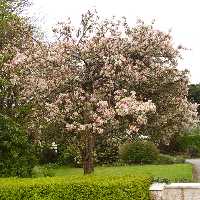
nectar sources in West Cornwall
West Cornwall has woodland, copses, hedgerows, cliff sides, derelict land, roadsides, pathways, rivers, streams and gardens, where flowers grow in abundance. The ubiquitous sycamore usually guarantees excess honey for the bees to carry them through to the ubiquitous brambles which usually guarantee a overall surplus for the beekeeper. These and a range of other plants are common and provide nectar and pollen all year round. Early examples include willow and blackthorn, spring brings wild cherry, dandelion and hawthorn, with horse-chestnut where it grows, summer clover, especially the later flowers in fields previously cut for silage.
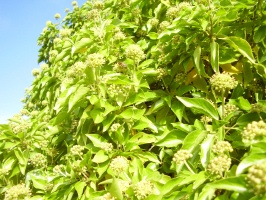 Ivy ends the year often producing rapid colony expansion and healthy winter bees with copious honey stored for winter use (which sets hard and can cause problems in spring as the bees find it more difficult to remove for food. The hedgerows and cliffs harbour a range of wild herbs and the hills grow different heathers in abundance, Cornish heath, bell and ling. Bees can often be seen flying in our mild mid-winter, for example on New Year's Eve and New Year's Day. Gorse can be abundant during the winter, certainly providing pollen along with hazel and probably nectar. There is also a huge range of wild flowers not attractive to honeybees which support the solitary bees and bumblebees, some of which specialise in visiting specific families. Ivy is an example of a flower which attracts copious insects of many species in autumn, providing plenty for all, including the specialist Ivy Mining Bee.
Ivy ends the year often producing rapid colony expansion and healthy winter bees with copious honey stored for winter use (which sets hard and can cause problems in spring as the bees find it more difficult to remove for food. The hedgerows and cliffs harbour a range of wild herbs and the hills grow different heathers in abundance, Cornish heath, bell and ling. Bees can often be seen flying in our mild mid-winter, for example on New Year's Eve and New Year's Day. Gorse can be abundant during the winter, certainly providing pollen along with hazel and probably nectar. There is also a huge range of wild flowers not attractive to honeybees which support the solitary bees and bumblebees, some of which specialise in visiting specific families. Ivy is an example of a flower which attracts copious insects of many species in autumn, providing plenty for all, including the specialist Ivy Mining Bee.
converting nectar to honey
Honeybees carry the nectar back to the hive after adding the same enzyme we have in our saliva to break down sugars into simpler forms. Bees in the hive add more of this enzyme and their own antibiotic and evaporate some excess water from the nectar. At night, when all flying is complete, all the bees co-operate to evaporate most of the water remaining, so the honey produced has usually less than 20% water, and is ready for covering with a thin film of wax over each cell. The resulting concentration of sugars is high enough to prevent bacteria and fungi growing in the honey, giving it a very long storage capability. The impermeable wax cover keeps out moisture which would dilute the honey again, down to levels where these organisms would grow, cause fermentation and spoil the honey. The storage is like thousands of little wax jars with their own lids, which are opened one by one as needed by the bees!
West Cornwall's maritime climate
Weather patterns here are maritime: the Cornwall peninsula protrudes into the Atlantic where the Gulf Stream warms the western and southern sides of our British and Irish islands. The result is a warmer winter and cooler summer than further east and further north. The south-eastern corner of the country has a more continental climate, with colder winters and warmer, drier summers. The most southerly points in Cornwall's two mini-peninsulas are, however, amongst the warmest parts of the country even in summer. All my apiaries were well inland (up to about 4 km) and it is the south facing apiaries near Helston which benefited most from the extra warmth.
the annual beekeeping management cycle
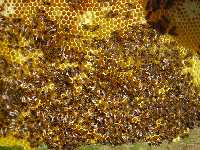
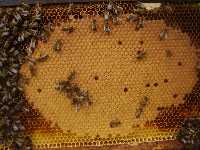
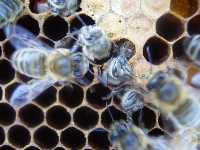
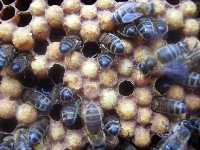
“All beekeeping is local” is an often quoted adage and West Cornwall's long, damp, warm winters, where late autumn, winter and early spring merge into one season and plants rarely stop growing, can catch out the unwary beekeeper. There seems to be a long, gradual start to the queen's laying and spring colonies can become quite vigorous when the main nectar flow starts some time in March. This nectar flow builds steadily until late April when it becomes very rapid throughout May, whose weather usually gives us at least two full weeks-worth of fine weather. Occasionally May has little sunshine, a lot of cloud and rain and (native) queens reduce laying to compensate. During these times, colonies expand rapidly as the queen lays more and more eggs in response to the nectar and pollen income. Lately colonies seem to have developed rapidly earlier. The further west you go, the earlier is the season. This means two things: the likelihood of early swarming (late March for one unwary beekeeper recently) and a potential bumper spring harvest on the sycamore and occasionally on the hawthorn, which needs higher temperatures.
The summer flow generally started for my apiaries in late June and continued through July to the first week in August, when it tails off substantially, often suddenly with the late summer winds. Summer weather patterns again are variable, though we can usually rely on two weeks-worth of fine weather in which a normal surplus builds up, sometimes concentrated. Irregularly, many months can contain the bees in their hives away from the cold and wet, during which time they can eat their hard won spring stores (often June is like this, but so can May, when we hope to rely on a rapid build-up of colonies!). It is these stores, which differentiate the honeybee from the bumble bees and solitary bees and give it huge advantage in poor seasons and allow it to survive and even develop slowly in the winter months. Latterly, we have had long dry spells with little nectar in the flowers. Overall the climate seems to be changing steadily with everything starting earlier and management getting more precise, especially to anticipate and deal with potentially increasing disease.
feeding bees sugar syrup
My own practice was to feed the bees as little as possible and never to feed a production colony when the added sugar might get into the honey. Latterly I used a proprietary bee feed, such as Ambrosia and towards the end in 1000kg containers for winter feeding, swarms I collected and for queen rearing and nucleus building! Nuclei are starter colonies for sale and for replacement of poor queens.
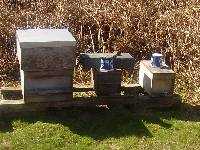 Priorities for feeding sugar syrup are firstly, nuclei (small colonies), usually with a new queen held until her performance is clearly good or an old replaced queen stored for emergencies. Nuclei do not have enough bees to give the queen and her new brood enough food to grow quickly. Given sugar syrup, the flying bees can deploy their limited resources to collect more pollen, which provides the protein for building new bodies. Secondly, swarms draw comb rapidly and continue doing so as long as they are fed. This means they use less later to create the storage space for their honey (and my surplus!) as well as being assisted to expand as fast as they can. In this way, an early swarm can produce a surplus on the summer flow. Thirdly, our June can be poor and colonies eat any surplus they brought in during spring. They must be fed once their stores reduce below 5 kilos or so, else they might starve before the next visit (our bees reduce laying with less than 10 kilos). Fourthly, in autumn, after the honey surplus is removed and before the ivy flow, any colony with less than 15 kilos stores is fed until it reaches that target. They need at least this amount to get through the winter and a poor spring. I believe they overwinter better and build up in spring better on their own stores and I prefer colonies which fill the brood chamber with honey after the queen reduces the nest in late summer. Fifthly, I did stimulate some colonies in the spring: overwintered nuclei never have enough stores; weaker colonies grow faster with stimulation; colonies with a mass of crystrallised ivy honey find it easier to convert with a weak watery sugar syrup (40% or less); colonies I want to grow for bees to assist queen rearing expand and draw new comb rapidly with syrup. Latterly I tried out Ambrosia syrup, which saves the bees the energy involved in reducing sucrose.
Priorities for feeding sugar syrup are firstly, nuclei (small colonies), usually with a new queen held until her performance is clearly good or an old replaced queen stored for emergencies. Nuclei do not have enough bees to give the queen and her new brood enough food to grow quickly. Given sugar syrup, the flying bees can deploy their limited resources to collect more pollen, which provides the protein for building new bodies. Secondly, swarms draw comb rapidly and continue doing so as long as they are fed. This means they use less later to create the storage space for their honey (and my surplus!) as well as being assisted to expand as fast as they can. In this way, an early swarm can produce a surplus on the summer flow. Thirdly, our June can be poor and colonies eat any surplus they brought in during spring. They must be fed once their stores reduce below 5 kilos or so, else they might starve before the next visit (our bees reduce laying with less than 10 kilos). Fourthly, in autumn, after the honey surplus is removed and before the ivy flow, any colony with less than 15 kilos stores is fed until it reaches that target. They need at least this amount to get through the winter and a poor spring. I believe they overwinter better and build up in spring better on their own stores and I prefer colonies which fill the brood chamber with honey after the queen reduces the nest in late summer. Fifthly, I did stimulate some colonies in the spring: overwintered nuclei never have enough stores; weaker colonies grow faster with stimulation; colonies with a mass of crystrallised ivy honey find it easier to convert with a weak watery sugar syrup (40% or less); colonies I want to grow for bees to assist queen rearing expand and draw new comb rapidly with syrup. Latterly I tried out Ambrosia syrup, which saves the bees the energy involved in reducing sucrose.
frame replacement frequency
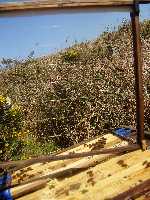
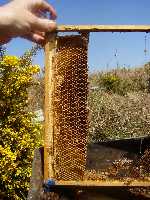
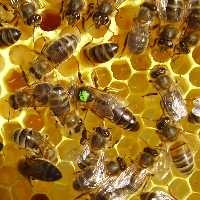
It is our practice to replace 3-4 frames in each hive each year so that comb is replaced every 3 years. This reduces the pressure on colonies from any accumulated disease given that larvae defecate into the cell outside their cocoon (chalk brood, a fungal disease is rampant in West Cornwall; European Foul Brood, a bacterial disease is intermittently in our area and occasionally there is an outbreak of American Foul Brood, either from colonies imported from elsewhere in the UK or from honey jars left out and cleaned out by bees; it may be even be that the viral diseases propagated by varroa live on in the fecal matter). Each time a frame is replaced, a frame comes out. If it carries significant stores, these are fed back to that colony. Older frames in reasonable condition may also be used sparingly to attract swarms to bait hives. This saves the neighbourhood and my time collecting swarms as a service to the local community, because they can get into inconvenient places. My swarm prevention and control practices reduce the loss of swarms to 2% or so. Frames are cleaned of wax (which is rendered separately) and then soaked and washed in caustic soda.
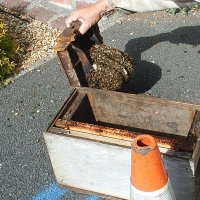
resources for beekeeping in West Cornwall
Further information on Beekeeping in West Cornwall and information from notes for students and local beekeepers can be found in notes.
I was a member of both West Cornwall Beekeepers Association and Cornwall Beekeepers Association. I acted as Newsletter editor for WCBKA (twice), course manager for its Basic Beekeeping course for the first 9 years and Librarian. WCBKA library was also the course library. Links will take the reader to UK, other British, Irish, continental European and overseas beekeeping websites and discussion groups.
vision of varroa tolerance in Cornwall, the peninsula
In 2002 I founded the Cornwall Bee Improvement and Bee Breeders Group with Lol Oakes (Chair) and Rodger Dewhurst (Treasurer) and act as secretary to the group. The group is affiliated to BIBBA, the Bee Improvement and Bee Breeders Association,which has an international membership. The vision was to use the advantages of the peninsula to provide an increasingly protected zone of improvement which can expand up the peninsula. For details go to the CBIBBG web pages.